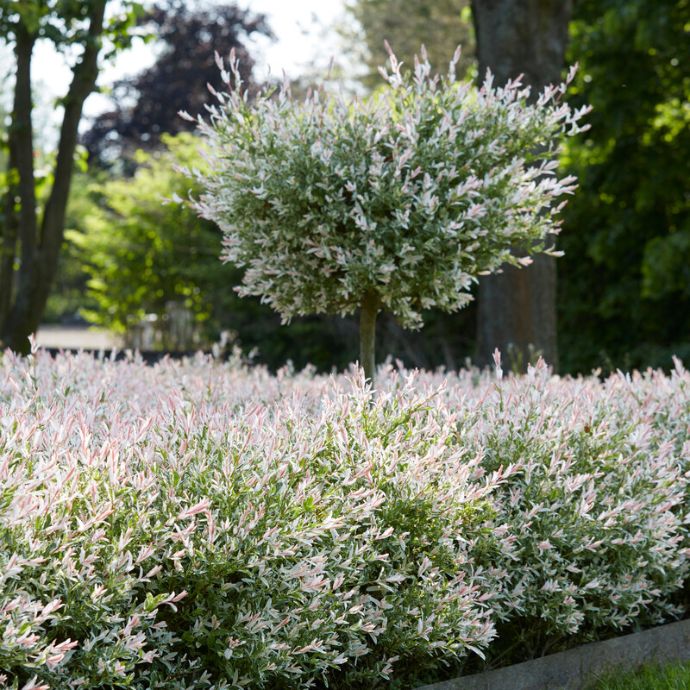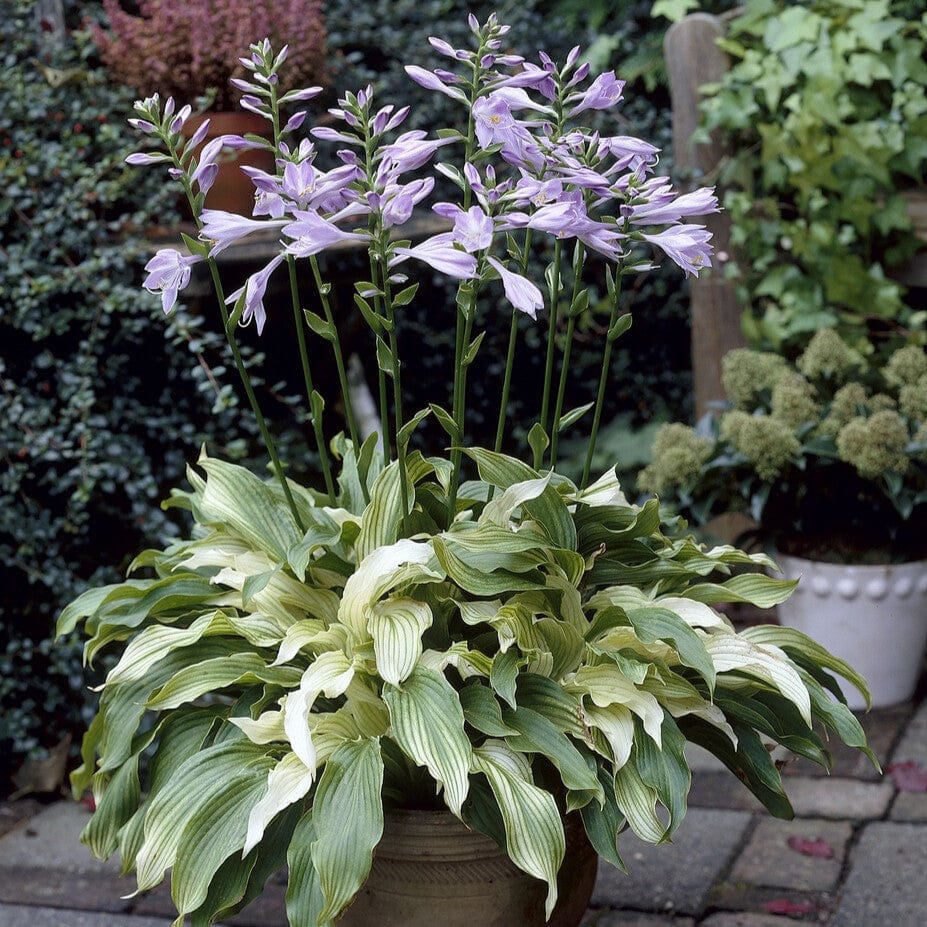Advice & Inspiration
Hosta Flowers: Getting the Best Blooms

Imagine a garden plant with leaves so eye-catching that you don’t even notice the flowers. Or even mention them. In fact many people plant a hosta and get the mother of all surprises when it starts blooming in June!
Some gardeners even (whisper it) cut the flower stems off. In any other plant I’m pretty certain these tall, swaying stems of flowers wouldn’t be quite so overlooked, but can a hosta help it if its leaves look so good?
I love hosta foliage as much as any gardener, but I think it’s about time their underrated flowers came out of the shade (not literally, they love that stuff) and got some of the attention they deserve, too. Here’s what you need to know about hosta flowers.
Jump to:
- Hosta flower appearance
- Flowering period
- Which hostas are best for flowering?
- How long do the flowers last?
- Are bees attracted to hostas?
- Hosta flowering problems
- Using hosta flowers
What do hosta flowers look like?
Hosta flowers grow on long stems (or scapes) which appear out of the middle of the hosta plant and stand above it. The tubular or bell-shaped flowers grow along the length of the upper stems. These vary a lot between different varieties, with stems growing anywhere between 15cm to 1.2m long and flowers varying in size, too. Some hosta flowers are strongly fragrant while most have only a slight scent.
You’ll most often see hosta flowers in a soft lavender purple colour, but there are several varieties with deeper purple or white flowers too. With interest in hosta flowers increasing, some varieties are now being bred for their flowering as well as their leaves, so we’re starting to see more pinks, creams, pale blues and even red tones appearing. There’s even one variety with yellow flowers, called Miracle Lemony.

When do hostas flower?
You can expect your hosta to flower between late spring and late summer, according to which type you have.
Hosta sieboldiana
These are early-flowering hostas which usually bloom from mid June to early July.
Hosta plantaginea
These hostas are late-flowering varieties which tend to bloom in August. In warmer areas, you might find the flowering season starts in mid-May or extends into early autumn but, again, this depends on the variety.
Reblooming hostas
Some hosta varieties are rebloomers – they flower twice a year. If you have one of these, you’ll need to prune out the first lot of flower scapes as soon as they’re finished, in order for the plant to produce a second flush later in the summer.

Which hostas produce the best flowers?
All hosta plants will produce flowers as long as they have the right growing conditions (see below) but some have more or better blooms than others. Some of the best varieties for flowers include Blue Cadet, Lakeside Looking Glass, Moonlight Sonata, Raspberry Sorbet and the ‘Sparkling’ series.
Of course, the hosta you choose will depend very much on your personal preferences with regards to flower colour, scent level, plant size and leaf colours. They’re such well-loved plants that there are hundreds of different varieties, with more being bred all the time, so you have plenty to choose from.

How long do hosta flowers last?
Although an individual hosta flower will only last for a single day, there are likely to be ten or more scapes on your plant, each with around fifty flowers that open gradually over the course of four or six weeks, so the overall bloom time is comparatively long.
Reblooming hostas extend the flowering season even longer: once all of the flowers on a scape are finished, you can cut it down and the plant will grow a new one.

Do bees like hosta flowers?
Hostas are valuable plants for wildlife, providing shelter and shade for insects, birds and small mammals, as well as a source of drinking water as it collects in the leaf folds. If you leave the flower stems intact when the blooms have faded, birds will come and eat the seed heads throughout autumn and winter.
Hosta flowers are also attractive to pollinating insects, with their tubular shape proving particularly appealing to butterflies, moths and long-tongued bees. If you are choosing a hosta with bee appeal in mind, the scented varieties and those with deeper purple flowers are thought to be the most attractive to them.

Hosta flowering problems
If your hostas aren’t flowering, it could be for one of these reasons:
It’s too early
Hostas vary a fair bit in their flowering times, with some blooming in spring and others not until late summer, so you might just have to wait a little longer. You can check the flowering time for your particular hosta on our plant pages.
With younger plants, it can also take a couple of years until they’re mature enough to flower, so it’s just a case of watching and waiting while you enjoy the foliage.
The growing conditions are wrong
Although hostas are shade-tolerant plants, they do need a little sunlight daily in order to flower, so if yours isn’t blooming after a couple of years, it may be a good idea to replant it elsewhere, grow it in a pot or divide it so that you can have hostas in different locations.
Hostas don’t generally need fertiliser, but if yours isn’t growing as well as it could, It’s worth trying it with a feed, especially if your soil is a bit on the dry, sandy or clay side. Give your hosta a dose of general purpose plant food in spring and again in autumn to boost its growth, adding a mulch of well rotted manure or compost around the base at the same time.
Something’s eating it
Hostas are tough cookies and can generally cope with a bit of nibbling from the neighbourhood slugs. However if the plant is young and hasn’t had a chance to get established properly, or something bigger like a rabbit or deer takes a chunk out of it, this can weaken the hosta and force it to put all of its energy into growing new foliage rather than forming flower stems.
For slugs, you can try surrounding your hosta with a barrier of crushed shells, gravel or copper wire - or a mulch of bark chips which they can’t easily slither over. If your hosta munching visitor is a bigger animal, you may have to try putting up barriers, growing in a pot or even growing alongside peonies, aquilegia, phlox, tiarella or thalictrum, as rabbits hate those.
It’s just not meant to be
Some hostas just don’t have very impressive flowers. All of them will flower at some point and to some extent, but if yours are a little underwhelming, it’s probably just the way that particular variety is meant to look.
When you’re buying a new hosta, check to see if flowers are mentioned in the description - if they’re not, then you can assume that this variety has been bred primarily for the foliage and you shouldn’t expect floral wonders.

How to use hosta flowers
Hosta flower arrangements
Hosta flower stems are slender and upright, making them ideal for vases, especially if you team them with some of the hosta’s foliage. Don’t leave it too long to cut though – the individual flowers don’t stick around for very long so the best time to pick them is when only two of the buds have opened on the stem.
This means that the rest will soon follow, opening gradually over a couple of weeks. Trim the flowers off as they fade and keep the water levels topped up so your arrangement doesn’t dry out.
Edible hostas
Like the shoots and leaves of the hosta plant, their flowers are edible too. Whereas the leaves are said to taste somewhere between asparagus and artichoke with a hint of leek, the flowers have a sweet, floral taste similar to many other edible petals or buds, like roses and hollyhocks.
Unlike other parts of the plant, you won’t have to damage your plant to sample the flowers or buds – just pick them off. They can be used in salads or as a dessert garnish or sugared and used to decorate cakes and sweets. I guess those slugs were on to something!




















